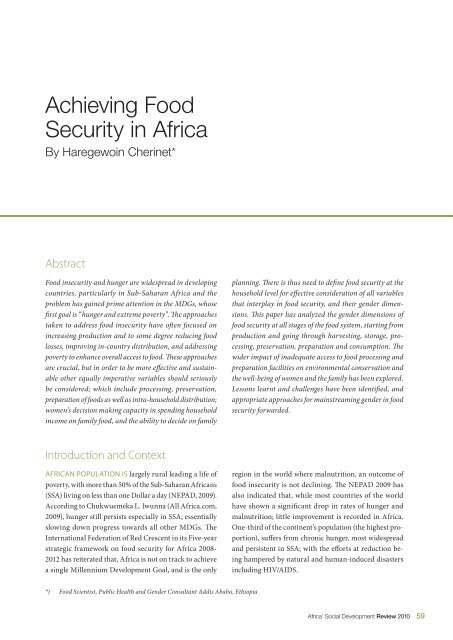The African Social Development Review - United Nations Economic ...
The African Social Development Review - United Nations Economic ...
The African Social Development Review - United Nations Economic ...
Create successful ePaper yourself
Turn your PDF publications into a flip-book with our unique Google optimized e-Paper software.
Achieving FoodSecurity in AfricaBy Haregewoin Cherinet*AbstractFood insecurity and hunger are widespread in developingcountries, particularly in Sub-Saharan Africa and theproblem has gained prime attention in the MDGs, whosefirst goal is “hunger and extreme poverty”. <strong>The</strong> approachestaken to address food insecurity have often focused onincreasing production and to some degree reducing foodlosses, improving in-country distribution, and addressingpoverty to enhance overall access to food. <strong>The</strong>se approachesare crucial, but in order to be more effective and sustainableother equally imperative variables should seriouslybe considered; which include processing, preservation,preparation of foods as well as intra-household distribution;women’s decision making capacity in spending householdincome on family food, and the ability to decide on familyplanning. <strong>The</strong>re is thus need to define food security at thehousehold level for effective consideration of all variablesthat interplay in food security, and their gender dimensions.This paper has analyzed the gender dimensions offood security at all stages of the food system, starting fromproduction and going through harvesting, storage, processing,preservation, preparation and consumption. <strong>The</strong>wider impact of inadequate access to food processing andpreparation facilities on environmental conservation andthe well-being of women and the family has been explored.Lessons learnt and challenges have been identified, andappropriate approaches for mainstreaming gender in foodsecurity forwarded.Introduction and ContextAFRICAN POPULATION IS largely rural leading a life ofpoverty, with more than 50% of the Sub-Saharan <strong>African</strong>s(SSA) living on less than one Dollar a day (NEPAD, 2009).According to Chukwuemeka L. Iwunna (All Africa.com,2009), hunger still persists especially in SSA; essentiallyslowing down progress towards all other MDGs. <strong>The</strong>International Federation of Red Crescent in its Five-yearstrategic framework on food security for Africa 2008-2012 has reiterated that, Africa is not on track to achievea single Millennium <strong>Development</strong> Goal, and is the onlyregion in the world where malnutrition, an outcome offood insecurity is not declining. <strong>The</strong> NEPAD 2009 hasalso indicated that, while most countries of the worldhave shown a significant drop in rates of hunger andmalnutrition; little improvement is recorded in Africa.One-third of the continent’s population (the highest proportion),suffers from chronic hunger, most widespreadand persistent in SSA; with the efforts at reduction beinghampered by natural and human-induced disastersincluding HIV/AIDS.*) Food Scientist, Public Health and Gender Consultant Addis Ababa, EthiopiaAfrica’ <strong>Social</strong> <strong>Development</strong> <strong>Review</strong> 201059
















